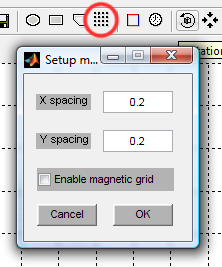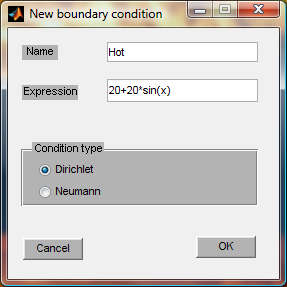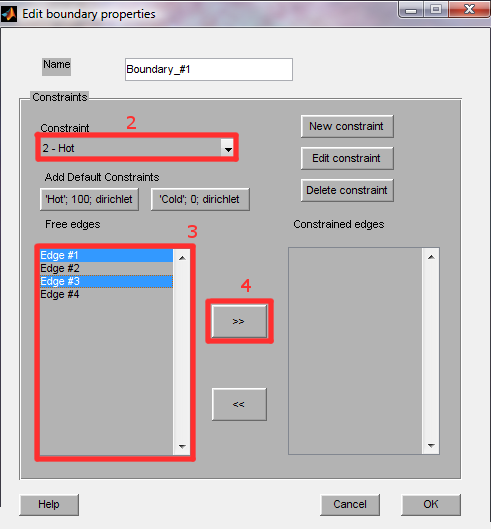
Fig 1 - Overview
This program solves the time dependant Laplace and Poisson equations on an arbitrary mesh by using the finite element method. The mesh is generated by using the NAG d06 routines on boundaries drawn by the user. Three different routines are available, using three different algorithms for the mesh generation: d06aa (incremental), d06ab (Delaunay) and d06ac (Advancing front). d06ba is also used to subdivide the boundaries. The linear system is solved using the f11 routines: f11zb (renumbering), f11ja (preconditioning) and f11jc (solving). The user can set boundary conditions, choose the time parameters and export the results of the simulation.
The interface is divided in 6 parts: the drawing area, the toolbar, the boundaries list, the algorithm selector, the equations buttons and the help text area.

The drawing area allows the user to draw the domain on which he wants to solve the equations. It's also the place where the solution is displayed. In the drawing mode, the user can add boundaries using three different tools (circle, rectangle and polylines). A grid is available to help the user drawing straight lines, it can be configured through the toolbar button. In the visualisation mode, several tools are available to see the solutions in different angles and drawing modes by using the toolbar.
The user can delete or edit the boundaries of the selected domain. When editing a boundary, the user can change its name and decide to apply different conditions on each edge of the boundary.
The user can choose which algorithm to use to generate the mesh and can configure each algorithm separately.
The program solves the chosen equation when the user clicks on the buttons. For the poisson equation the user has to enter the source term.
In all the expressions (initial value, source term or conditions) the syntax is checked. The user can use 3 variables in these expressions: x, y and t for the current point coordinates and time. Every correct matlab expression using only these variables (or none) are allowed.
All the program settings are saved in a XML file named config.xml.
This tutorial will demonstrate how to configure the drawing area. The following tutorials will use the same configuration.


This tutorial demonstrates how to use the polyline tool.
WARNING: Do not cross the lines of the polygon or click twice on the same vertex, as this will result in an error!


This tutorial will demonstrate how to use the basic functions of the program to solve the Laplace equation on a square.
The first thing to do is to draw the domain we want to solve the problem into. This is done in 5 steps (assuming you have already configured the drawing area).

Now we have to add some boundary conditions
 . A dialog will show up
. A dialog will show up
NB: If you wish to edit the condition, click on Edit in the Boundaries panel, select the condition from the drop down list, and click 'Edit constraint'. Make your changes and click OK.

Then we assign the conditions to the boundary edges


Now we change the time parameters


Everything is ready we can now hit the 'Laplace' button. You will be asked the initial value, leave '0'. When the solving is finished you can watch the solution by clicking on the play button from the toolbar . At the end of the animation you should see the steady state as in Fig 8.
. At the end of the animation you should see the steady state as in Fig 8.
